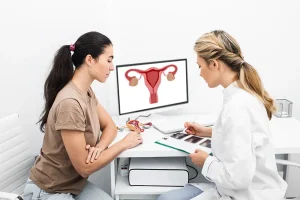Statistically, 3 out of 100 women will be diagnosed with endometrial cancer during their lifetime. This condition ranks as the sixth most common cancer worldwide and the 14th leading cause of death among women. Early diagnosis plays a crucial role in successful treatment outcomes.
At VenArt Clinic, we specialize in gynecological surgery and gynecological oncology. Our team of highly trained doctors combines advanced surgical expertise with innovative medical technology. This ensures our patients receive the highest quality care and long-lasting results. For more details, please visit the Gynecological Oncology section of our clinic.
What Is Endometrial Cancer?
The uterus is composed of three layers of tissue. The outer layer, known as the perimetrium, surrounds the uterus. The middle layer, called the myometrium, is made up of muscle fibers, while the inner lining, the endometrium, is the functional layer shed during each menstrual cycle. Unlike uterine sarcoma, which affects the muscular middle layer, endometrial cancer develops within the endometrium and is much more common.
Endometrial cancer begins when cells in the endometrium start to grow abnormally. Instead of following the natural life cycle of healthy cells, these cancerous cells multiply uncontrollably and accumulate into a tumor. The exact causes are not fully understood, but genetic mutations in cellular DNA play a central role. These mutations alter normal function and allow cells to grow without regulation.
What Are The Symptoms of Endometrial Cancer?
The most common and striking symptom of endometrial cancer is abnormal vaginal bleeding. This can appear in several forms, including changes in menstrual cycle length, bleeding between periods, or unexpected bleeding after menopause. Because post-menopausal bleeding is never normal, this sign should always be investigated promptly. Early evaluation can lead to quicker diagnosis and better treatment outcomes.
Other Symptoms That May Indicate Endometrial Cancer
Other possible symptoms include abnormal vaginal discharge, pelvic or lower abdominal pain, and discomfort during sexual intercourse. These signs are not exclusive to cancer and may be caused by other, less serious conditions. However, it is essential not to dismiss them and to consult a gynecologist as soon as they appear. Early medical evaluation remains the safest approach.
How Is Endometrial Cancer Staged?
Staging helps doctors determine how far the cancer has spread and guides treatment decisions. In Stage I, the disease is limited to the uterus. In Stage II, cancer is found in both the uterus and cervix. By Stage III, the tumor has spread outside the uterus but not to the rectum or bladder, and it may involve the ovaries, fallopian tubes, vagina, or lymph nodes.
Stage IV represents advanced cancer, with spread beyond the pelvic area to the bladder, rectum, or distant organs. Fortunately, most cases are detected early because symptoms appear earlier than with other gynecological cancers. When diagnosed in the initial stage, 85–90% of women achieve remission. Delayed detection significantly reduces the chances of cure.
Treatment Options For Endometrial Cancer
The primary treatment for endometrial cancer is surgical removal of the tumor. A total hysterectomy, which includes removal of the uterus and cervix, is the most common approach. Depending on the surgical method, this can be performed vaginally, through a large abdominal incision (total abdominal hysterectomy), or through small incisions using laparoscopic instruments (total laparoscopic hysterectomy). Each technique is chosen according to the patient’s condition and medical needs.
In some cases, a radical hysterectomy may be necessary. This procedure removes the uterus, cervix, and part of the vagina, and may also involve removal of the ovaries, fallopian tubes, or nearby lymph nodes.
A lymph node dissection, also known as lymphadenectomy, may be performed to check for cancer spread under microscopic examination. These surgical options ensure both treatment and accurate staging of the disease.
After surgery, some patients may require additional therapies. Radiation therapy or hormone therapy may be used to destroy any remaining cancer cells and reduce the risk of recurrence. This approach, known as adjuvant therapy, is tailored to the patient’s stage of disease and individual medical profile. The goal is to maximize both survival and quality of life.
Endometrial Cancer And The Pap Test
The Pap test is a valuable screening tool, but it does not detect endometrial cancer. Instead, it collects cells from the cervix to identify abnormalities that may lead to cervical cancer or highlight other gynecological conditions. While widely believed to cover all uterine cancers, this is a misconception. Endometrial cancer cannot be diagnosed or predicted through the Pap test.
How Can We Reduce The Risk Of Endometrial Cancer?
Although prevention cannot be guaranteed, several lifestyle choices can help lower risk. Maintaining a healthy weight is crucial, as women with a high body mass index face three times the risk compared to women of normal weight. Regular physical activity has been shown to significantly reduce the likelihood of developing the disease. These simple yet powerful measures form the foundation of prevention.
Other strategies include discussing hormone therapy risks with your gynecologist. Estrogen-only replacement therapy after menopause can increase cancer risk if the uterus has not been removed.
Oral contraceptives, when taken for at least one year, can also lower the risk, with the benefits lasting years after discontinuation. However, because contraceptives carry potential side effects, it is important to make this decision together with your doctor.
Take control of your health today. Schedule a consultation with one of our experienced gynecological oncology specialists and receive the care you deserve. Together, we will find the safest and most effective treatment path for you. Contact us here to book your appointment.











